CPA Goal optimization is the most advanced way of hitting maximum conversions at an affordable CPM or CPC price. Advertisers and affiliate marketers can now command our smart algorithm to select traffic corresponding to their target eCPA or the number of conversions. This solves the primary issue of massive traffic acquisition: turning quantity into quality.
In this guide, we will go over the main benefits of the Adsterra optimization algorithm and lay out the setup process step by step.
CPA Goal’s top-rated benefits for advertisers
- Quality over quantity: you buy tons of impressions but optimize them by critical marketing parameters.
- Safety from overpaying: the algorithms will check every placement that reaches the critical spending you mark and verify if it delivers you the desired number of conversions or eCPA.
- Flexible price configurations: you can create a set of rules that will automatically verify traffic and sort the best slices.
- Automated placement unlinking: once a placement doesn’t meet your rules, it will be unlinked.
- Protection from false unlinking: when an ad placement hits the critical spending mark but keeps delivering you enough conversions or desirable eCPA, we keep it in your campaign. We will recheck the placement after several days to make sure it still meets your KPIs.
*You can also return unlinked placements to your ad campaign. We’ll get this topic covered in the FAQ section at the end of this guide.
What CPA Goal optimization is for?
This feature is vitally important for advertisers who have put conversions as their KPI, but acquire traffic using CPM or CPC pricing models.
Formerly, you had to manually unlink and blacklist placements that spend too much and deliver few conversions. Now you possess a game-changing tool to save CPM/CPC budgets.
CPA Goal will automatically unlink placements that get flagged by criteria you set, either eCPA or the number of conversions. No more jumping between your tracker and Adsterra to create a blacklist: our intelligent algorithm will do all the jobs.
eCPA stands for “effective cost of conversion.” The eCPA formula will be = Spending / Number of conversions.
Video tutorial
We explained the whole ad automation process in this short tutorial. You will learn how to optimize campaigns gaining the most converting traffic slices.
How CPA Goal increases your ad performance
The tool provides the opportunity to buy CPM or CPC traffic optimizing it by two parameters: the average cost of conversion and the number of conversions. How does it work? You create a rule for our intelligent algorithm.
First, you enter a critical spending amount. Upon reaching this spending, our algorithm will check all each placements if they comply with your next vital parameters:
- conversions
- eCPA
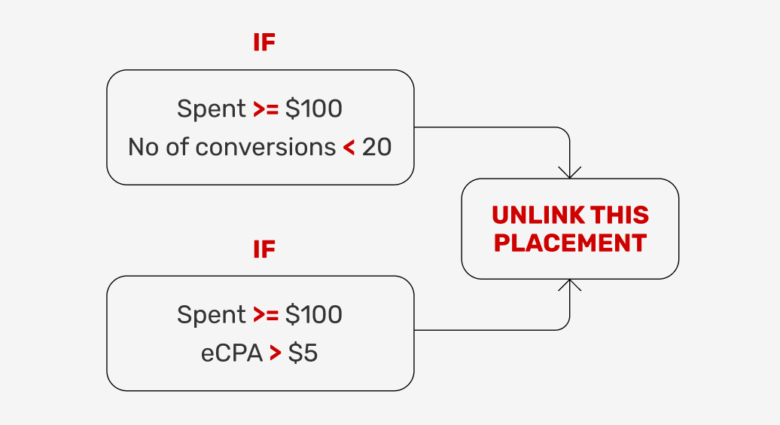
Case study: eCPA twice lower with rules-based optimization
Here is how CPA Goal helped our direct advertiser, a local online store. A Brazilian e-mall was launching a promo campaign aiming to embrace new audiences. Thanks to smart optimization, our advertiser managed to reduce eCPA almost by half, while growing the number of conversions and ROI.
Background:
- Vertical: E-commerce
- Conversion flow: first order
- Geo: Brazil
1st campaign
- 14 days
- CPM pricing (no auto-optimization)
- eCPA = $12
- 2327 conversions
2nd campaign – with optimization
- 14 days
- CPM pricing with CPA Goal added
- Rule: If eCPA is >$7, then unlink the placement
- eCPA = $6–7
- 2619 conversions
Smart rules allow for managing huge traffic volumes and achieve your desirable KPIs much faster.
How to use CPA Goal optimization by Adsterra?
Before you start
To begin with, you need an Advertiser’s account. Please remember to confirm your email while registering.
Your next step after the registration — if you plan to acquire traffic — will normally be putting funds, but we will now skip this part. With Adsterra, you can access any feature without topping up the account.
S2S tracking is a must for any conversion-based activities, so please ensure you have set it up.
How to set up the CPA Goal tool?
The following step is to create or choose a CPM or CPC campaign you will then optimize. Let’s suppose you intend to set up a new one. From the vertical menu, hit Campaigns > Create.
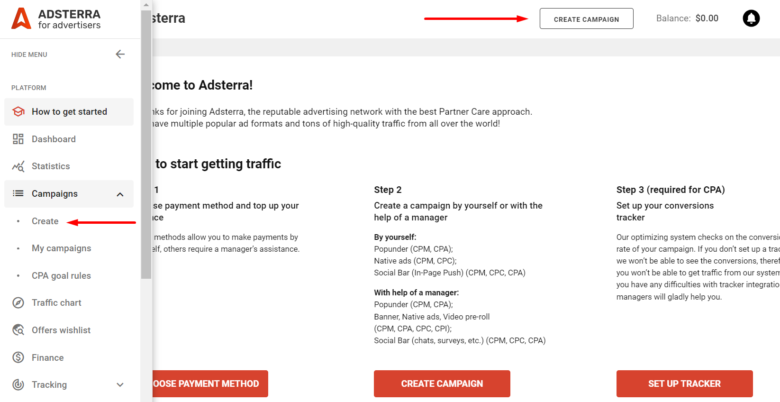
On the first screen, you have only general settings listed. Please add your campaign name, pick the ad unit (e.g., In-Page Push), choose traffic and connection type, decide on the device type, and add your landing page’s URL.
Remember to include the ##SUB_ID_SHORT(action)## token to the URL and match it with your tracker’s “clickID”.
To enable further optimization, pick CPM or CPC pricing type. Please note that if you select a CPA campaign, the CPA Goal setup option will not appear on the page.
Now choose a country and add a payout (bid). You can use the Traffic Estimator’s clues and enter the recommended bid.
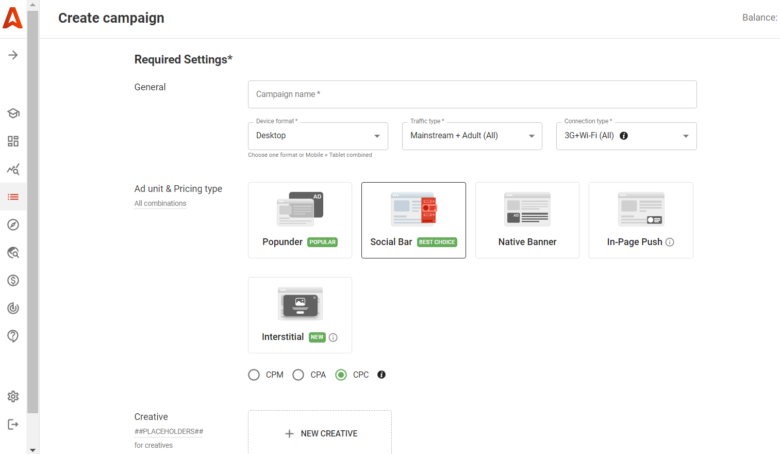
One step left to enable CPA Goal: jump to Step 4 – Advanced settings. Scroll to the CPA Goal section. Let’s now add a new rule.
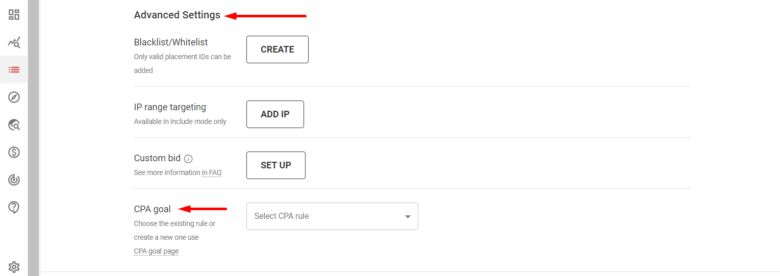
Important parameters to include in your rule
Ok, you’re about to add a new rule. Now click on the CPA Goal page link.

As we’ve found out, there’s one critical metric — your spending amount. By hitting it, your campaign will be checked by Adsterra AI algorithms. Please enter this amount in the Spent field ($).
Next, add one of the optimization parameters that will signal our system to unlink a placement if it hits this mark. It can be either eCPA or the number of conversions.
Click ADD RULE in the end.

As soon as you add the rule and click the SUBMIT FOR REVIEW button, your campaign will enter a verification stage. After we verify your campaign, you will be able to set it live, and the smart algorithm will be applied immediately to all CPM/CPC traffic you get.
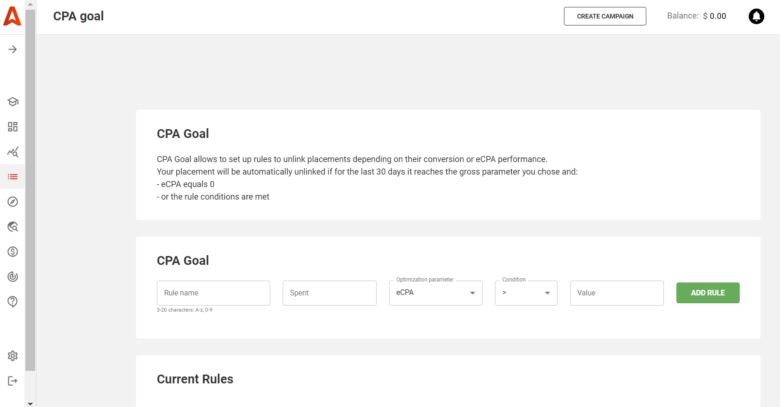
How to adjust and update rules?
Actually, there is a more convenient way to create, adjust, and update the rules for AI-powered optimization. From the vertical navigation bar, hit Campaigns > CPA Goal rules. On a new page, you can create rules to easily apply them to any campaign.
Below is the list of all optimization rules added. By clicking the Edit icon, you can correct the parameters, and the changes will be applied immediately.
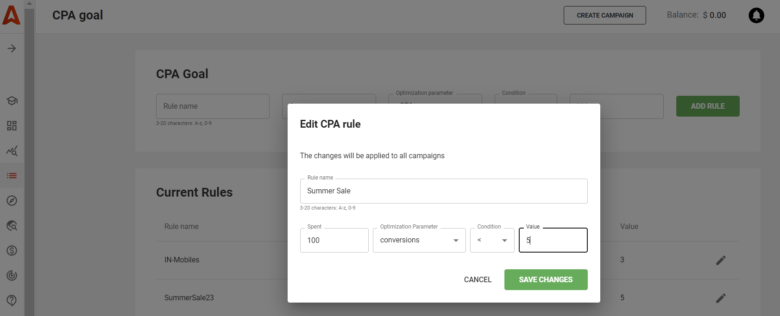
Summarizing the best hacks for CPA Goal optimization
We’ve made sure it’s an advanced optimization strategy powered by intelligent algorithms. It allows advertisers and affiliate marketers to reach the target payout for a conversion (CPA) while purchasing CPM or CPC traffic. This way, they pay less for traffic since they pay for ad impressions or clicks but achieve better results by optimizing this traffic by conversions or eCPA.
- Embrace huge amounts of traffic while testing and scaling your digital marketing campaigns
- Manage the number of conversions you can get with your targeting settings and
- Control your spending and virtuously allocate budgets for the long-run campaigns
- Set up global-reach advertising campaigns without risks of overspending
Frequently asked questions (FAQs) about CPA Goal:
Although both tools are related to traffic optimization, there is a difference in their approach. With Target CPA, you mainly mark a concrete cost per conversion you’re aiming at. This is what happens when you choose these tools from AppleAds. On the contrary, CPA Goal asks you to enter critical parameters to filter out ad placements that are unlikely to send enough quality conversions.
Yes, we use advanced machine learning algorithms to optimize CPM/CPC inventory for conversions and eCPA. These algorithms carry on complex data analysis to identify competition and select ad placements that align with your KPIs.
Adsterra CPA Goal is not a bidding model. Instead, it is an optimization algorithm that can be applied to CPM or traffic. It enables you to automatically remove ad placements and exclude those that produce fewer conversions or cost too much.
The tool may not be suitable for all campaigns. It requires a substantial number of impressions from your targeting, and it may not be the ideal tool for complex and expensive conversions like purchases and orders. If your campaign involves such conversions, and you’re new to Adsterra, it is better to run a classic CPM campaign, manually optimizing traffic slice by slice. Previously, we published a guide to running E-commerce ads where we listed several pro tips from our experts.
With some offers and products, it is much cheaper to buy impressions or clicks. In E-commerce, for instance, every user action costs pretty much. But when you purchase CPM/CPC traffic, you can try all targets and embrace more impressions while keeping your KPIs safe thanks to smart optimization.
It depends on many factors, such as your strategy, your vertical, your targeting, and more. If you notice you don’t get enough traffic, it is better to recheck the current amount of traffic available for your geo (you can do it using Traffic Chart) and the recommended bid.
Open your current campaign with an active rule and scroll down to the Advanced settings section. All unlinked placements will be listed in a table.
In this table, you get all IDs excluded from your current campaign and the date when they were unlinked. You can look for a specific placement ID using the search field, select and copy IDs, download all unlinked placements as .CSV to save it as a blacklist for your further campaigns.
And the most important move: you can remove the placement or a group from this list returning them to your campaign. To do so, select one or several placements and hit Remove selected IDs.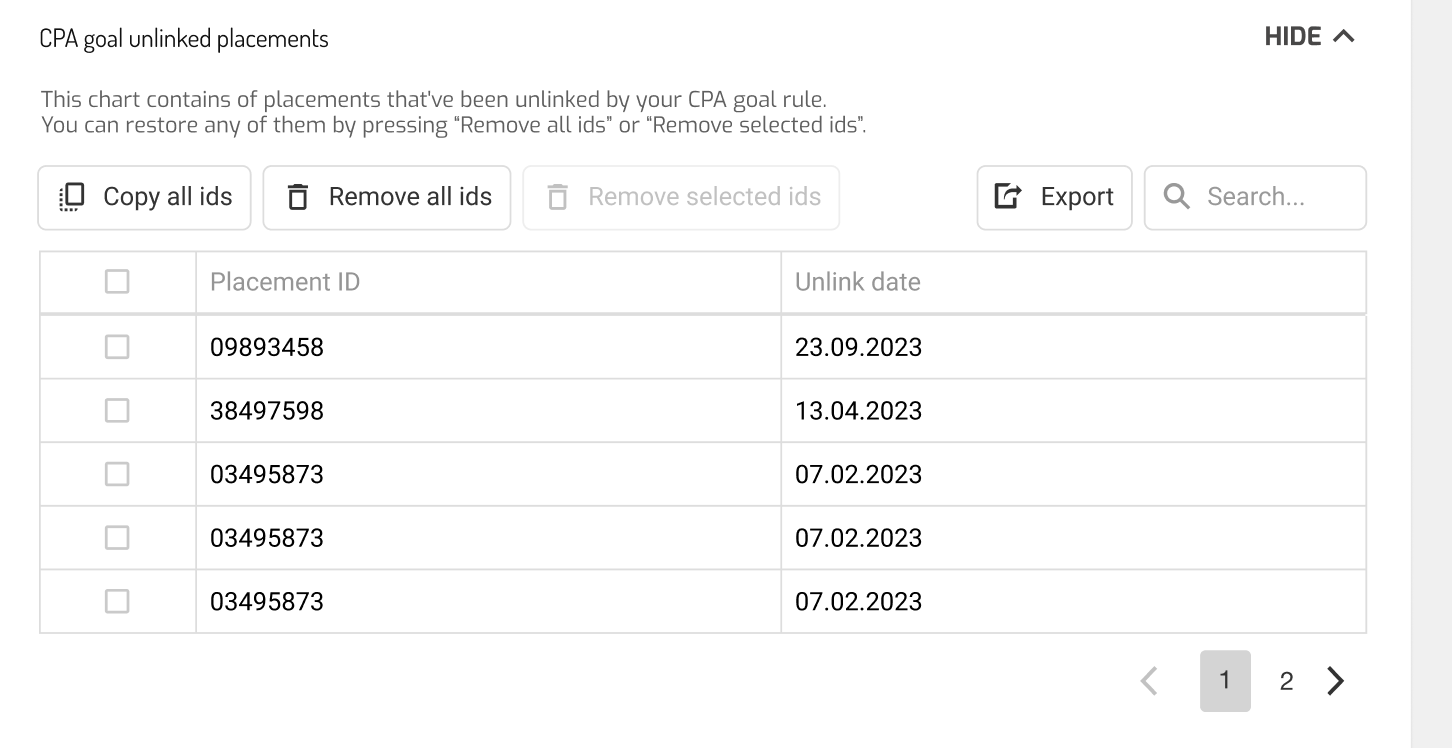
Of course. You can create, edit and save as many rules as needed and apply them to any of your campaigns from the CPA Goal rules page.
